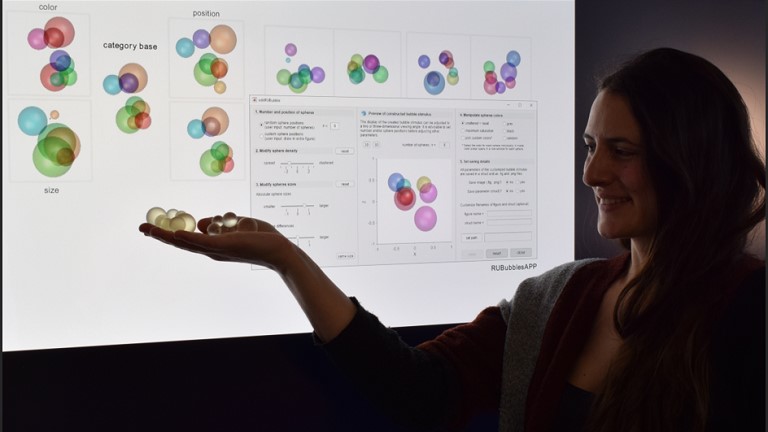
Categorisation learning:RUBubbles simplify researchers’ lives
New open-source software facilitates stimulus generation and enables customisation
Dividing the world into categories is a key component of cognition and facilitates daily life in a constantly changing environment. A team of researchers from Bochum has now succeeded in developing a new stimulus type to study categorisation learning: the so-called “RUBubbles”. The scientists have now published their toolbox in the journal Behavior Research Methods.
RUBubbles are digitally generated and allow a high degree of customisation at low computational cost. The entire MATLAB code required is freely available as open source code. With the help of RUBubbles, researchers are now able to generate large stimulus sets very quickly, which also contain all the advantages of artificial categorisation stimuli.
Whether cartoon animals, random dot patterns or Picasso and Monet paintings. A wide variety of stimuli are used in science to study categorisation learning – in both human and animal subjects. “A common approach is initial training with several stimuli and subsequent testing of categorisation with new stimuli,” says Aylin Apostel, lead author of the study. “It is essential to exclude memorisation in order to obtain valid research results. Thus, the researchers always face the challenge of offering the test subjects new and unfamiliar stimuli during testing, but at the same time staying close enough to the trained stimuli so that a conclusive categorisation can take place.”
Variable in four stimulus properties
The newly developed “RUBubbles” are visual artificial category stimuli consisting of randomly placed, coloured spheres. The number of spheres, their position in 3D space, sphere size and colour can be set and controlled separately as stimulus parameters.
Every scientist can individually adapt the RUBubbles to the needs of his or her research project.
Prof. Dr Jonas Rose
Every scientist can individually adapt the RUBubbles to the needs of his or her research project,” explains Prof. Dr. Jonas Rose, who works on neuronal basis of learning at the Bochum Faculty of Psychology.
By using RUBubbles, it is possible to precisely control individual stimulus properties and thus investigate their separate influence on the categorisation performance of different subjects.
In contrast to existing stimulus types, a large number of unique RUBubble stimuli can be quickly created. By adapting the RUBubbles to specific training procedures, different properties and strategies of categorisation learning can be investigated on a behavioural and neuronal level.
Useful addition to object recognition research
The uncomplicated generation of RUBubble stimuli could further facilitate studies that require larger amounts of unique stimuli, according to the research duo. RUBubbles would thus be a useful addition to, for instance, object recognition research.
All the MATLAB code needed is freely available as open source code and can be individually extended. In addition, the app can be used without programming experience or a MATLAB licence.
Aylin Apostel, lead developer of the toolbox
The stimuli can be controlled both purely programmatically and via a “RUBubblesAPP”. For a complete list of functions, the user manual and much more, the Bochum research team has set up a wiki at https://gitlab.ruhr-uni-bochum.de/ikn/rububbles/-/wikis/home. Rose emphasises: “Our RUBubble framework is intended as a living product that provides a solid foundation that can be further developed.”
(Editor’s note: Illustration of RUBubbles from https://link.springer.com/article/10.3758/s13428-021-01695-2/figures/2. Parts of the illustration have been modified).
